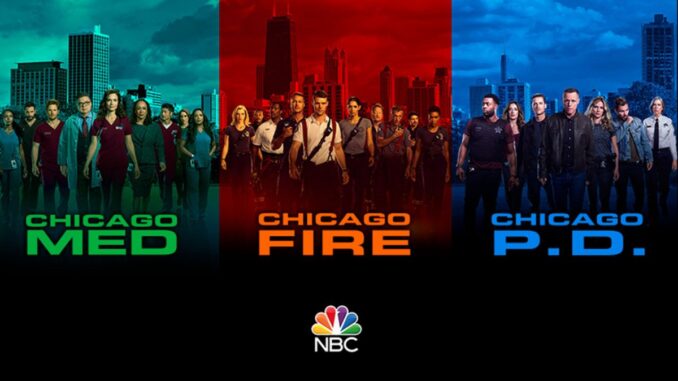
The Unraveling City: One Chicago 2025 and the Echoes of Ruin
The year 2025, in the hallowed halls of the One Chicago universe, was supposed to usher in an era of unity. After years of shared trauma and hard-won victories, the three branches – Fire, P.D., and Med – had forged an unbreakable bond. This year’s grand crossover event, "The Phoenix Rises," was slated to be a celebration of that resilience, centered around the re-opening of the historic Chicago Riverwalk, now a gleaming, revitalized hub of commerce and culture. It was meant to be a testament to the city’s ability to rebuild, to heal, to overcome.
No one, not the writers, not the network executives, and certainly not the millions of devoted fans, could have anticipated the seismic shockwave that would rip through that carefully constructed narrative. The initial marketing for "The Phoenix Rises" teased a grand, multi-episode mystery, perhaps a corrupt politician, a dangerous cartel, or a city-wide health crisis. What transpired, however, went far beyond a mere storyline; it was an existential gut-punch, a masterful, brutal series of explosion plot twists that would leave the fandom reeling, whispering, and arguing for months.
The first episode, "Burning Bridges" (Chicago Fire), opened innocently enough. Engine 51 and Truck 81 were on a routine call, a small kitchen fire that allowed for the usual banter and camaraderie. Simultaneously, Chicago P.D.'s Intelligence Unit was conducting surveillance on a low-level drug dealer near the Riverwalk, a seemingly unrelated case. Over at Med, Dr. Will Halstead was navigating a complex ethical dilemma with a new patient. The air was thick with the familiar, comforting hum of One Chicago.
Then came the first detonation. Not a bomb, not a massive, cinematic explosion, but a series of small, synchronized blasts along a newly constructed section of the Riverwalk. It was subtle enough to be initially dismissed as a utility malfunction, a gas leak gone wrong. But the immediate, frantic calls reporting multiple casualties, falling debris, and the first tendrils of panic snaking through the bustling crowds quickly shattered that illusion. Severide, Boden, and the crew of 51, already en route for a secondary assessment, arrived to find not a single, contained incident, but a spread of destruction that suggested a calculated, chilling precision. Concrete buckled, lampposts toppled, and the pristine glass facades of new cafes shattered, raining jagged shards onto screaming pedestrians.
This initial explosion was the first plot twist, a deliberate misdirection. It wasn't the big event; it was the diversion. As Firehouse 51 plunged into the chaos, pulling trapped victims from the wreckage, and P.D.'s Jay Halstead and Hailey Upton began to secure the perimeter, a second, far more insidious plot began to unfold. Intelligence, sifting through the early evidence, realized the blasts were too small, too localized, for a major terrorist attack. It felt like a message, a lure. And then the message arrived, not through a manifesto, but through the city's emergency broadcast system, hijacked by a chilling, digitized voice: "The city has been warned. The true target lies elsewhere."
The true target, the second explosion plot twist, was a gut-wrenching betrayal that nobody saw coming. The digital voice pinpointed a location: the newly upgraded, state-of-the-art emergency operations center (EOC) – the very heart of the city's crisis response, where key members of all three departments, including Chief Boden, Sergeant Voight, and Dr. Charles, were gathered for a crucial briefing on the Riverwalk incident. This was where the "One Chicago Family" truly resided, the place where their combined efforts were orchestrated. The perpetrators hadn't attacked the city; they had attacked them.
The EOC blast was not a series of small charges; it was a single, monstrous detonation that leveled the building. The sound echoed through the entire city, a horrifying counterpoint to the distant wail of sirens. Fans watched, horrified, as live aerial footage showed a mushroom cloud of dust and debris rising from the downtown core. The emotional impact was immediate and devastating. The very foundation of the crossover, the idea of their collective strength, had been shattered.
But the twists weren't over. As the dust settled and the rescue efforts shifted from the Riverwalk to the smoking crater that was once the EOC, a third, utterly shocking revelation emerged. Among the first responders to the EOC site, working with a grim determination born of sheer terror, was a face too familiar. A former colleague, a character thought to be long gone, believed to be dead or incarcerated, was found not among the victims, but among the perpetrators. This wasn't just a terrorist attack; it was an inside job, a calculated act of revenge or ideological warfare orchestrated by someone who knew their weaknesses, their protocols, their very hearts. The visual of a beloved, if complicated, face staring blankly from under a pile of rubble, identified as a key player in the destruction, sent shockwaves through the fandom that transcended mere storytelling. It was a violation of trust, a desecration of the family bond they had cherished.
"The Phoenix Rises" ended not with a triumphant resolution, but with a city in mourning, its heroes scattered and broken, and a lingering question mark over the very concept of safety and loyalty. The explosion plot twists weren't just about blowing up buildings; they were about blowing up assumptions, trust, and the comforting predictability of a beloved fictional world. It was a harrowing, brilliant, and ultimately unforgettable moment in One Chicago history, ensuring that 2025 would be remembered not for its unity, but for the devastating echoes of ruin.
